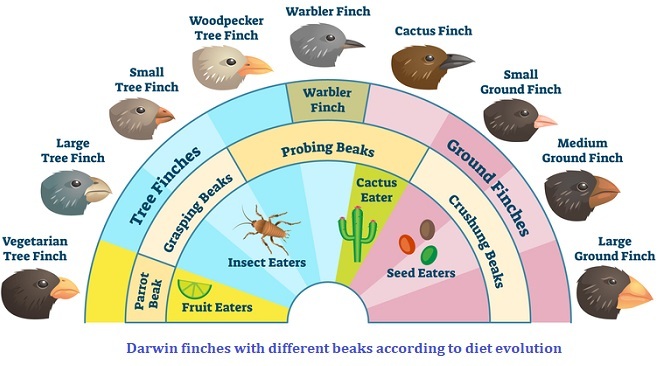

 The most crucial component of the theory of evolution is the principle of natural selection. The rationale behind the notion of natural selection lays the groundwork for how various creatures have evolved over millions of years on earth. Additionally, it is the foundation of Darwinism. The fact that Darwinism does not take into consideration a species' genetic mutations and genetic diversity is one of the theories' shortcomings. Neo Darwinism, a contemporary Darwinian derivative theory, addresses this issue.
The most crucial component of the theory of evolution is the principle of natural selection. The rationale behind the notion of natural selection lays the groundwork for how various creatures have evolved over millions of years on earth. Additionally, it is the foundation of Darwinism. The fact that Darwinism does not take into consideration a species' genetic mutations and genetic diversity is one of the theories' shortcomings. Neo Darwinism, a contemporary Darwinian derivative theory, addresses this issue.
First proposed by British naturalist Charles Darwin in his 1859 book "On the Origin of Species". The theory states that species change over time through the process of natural selection, in which individuals with favorable traits are more likely to survive and reproduce, passing their advantageous traits on to their offspring. Over time, these traits accumulate and lead to the development of new species.
It has been widely accepted by the scientific community and has been supported by a vast body of empirical evidence from fields such as paleontology, biology, and genetics. Darwin's theory continues to shape our understanding of the natural world and has broad implications for areas such as medicine, agriculture, and conservation biology.
Darwinism consists of five principles which are −
Over-production or prodigality of over-production − Overproduction, also known as prodigality of overproduction, occurs when more people are born each generation than can live and procreate.
Variation and Heredity − Within the same species, there is natural variance between individuals. A new species is often created as a result of the cumulative alterations an organism undergoes throughout time. Many of the advantageous modifications are inherited and handed along to the offspring of the next generations.
Intraspecific struggle − The same species' individuals engage in intraspecific conflict. Because individuals of the same species living in the same habitat have similar needs and requirements, intraspecific conflict can be fierce.
Interspecific struggle − It is present in creatures of several kinds that coexist. Members of one species compete with members of other species for resources including food, shelter, and mating.
Struggle with the environment − Living things fight to survive in unfavorable environmental situations including earthquakes, heat waves, cold waves, and floods.
Struggle for existence − While food production only increases in an arithmetic ratio, the number of organic beings grows by a geometrical ratio. So, unless anything happens to stop the growth, a region will quickly become overpopulated with any one species. As a result, there is a three-fold battle for survival, as described below.
Survival of the fittest or natural selectio − Organisms with particular traits have a higher likelihood of surviving and procreating than those with less advantageous traits.
Modifications of species − Through additive processes that occurred in the past and are continuing today, gradual alteration of species may have taken place throughout extended geological epochs.

The fundamental objections to Darwinism were that it only explained how the fittest survived, not how the fittest arrived.
The emergence of terrestrial animals from aquatic species cannot be accounted for by natural selection.
It did not address how the presence of vestigial organs and the effects of organ usage and inactivity. Vermiform appendix, for instance.
Darwinism assumed all variants to be heritable and did not distinguish between somatic and germinal variations.
The phenomenon of the extinction of species with several specialized organs was not explained. Example: The extinction of the mammoth.
Modern genetics theories and the mechanisms behind the emergence and persistence of traits in populations were not included in Darwin's hypothesis. The idea was altered in light of current studies. Numerous experimental findings have supported Darwinism. A synthetic hypothesis of evolution was put out in light of these findings and statistical information. This Darwinian hypothesis has been changed. Neo-Darwinism is the term for this.
Variations − Genetic differences were mostly unknown during Darwin's lifetime. Synapsis happens during meiosis and crossing over. Genes will reorganize as a result of this. resulting in the appearance of genetic variation or the occurrence of chromosomal abnormalities.
Mutations − Any modification to the DNA's nucleotide sequence will result in mutations, as would the replacement of one pair of nucleotides. Point mutations are the name given to these changes. These occur naturally and spontaneousl
Natural Selection − Natural selection uses a variety of biotic and abiotic pressures to decide how and where an organism will change.
Genetic Drift − When a portion of a larger population splits off, genetic drift develops in smaller populations. It is only possible for a small population to develop into a new subspecies or species if the representative genes of the big population change at the unexpected stage.
Isolation − Mutations Large spans of water can divide a population into several groups, each of which can transform. A new species will be created as a result. Therefore, isolation due to geography will lead to evolution.
Apart from the striking modifications that evolutionary theory based on natural selection has experienced since the publication of On the Origin of Species. The goal of the study is to identify the essential ideas of Darwin's original theory and show how they evolved through the neo-Darwinian synthesis. These fundamental ideas persist and help to distinguish a "Darwinian" approach to evolutionary biology from other methods, notwithstanding the substantial alterations that happened due to the unification of the theory with Mendelism through mathematical population genetics. Furthermore, each of those principles has been under constant philosophical strain for the growth of the theory.
Q1. What is Lamarckism ?
Ans. It states that Physical traits that the parent organism acquired via usage or inactivity during its lifetime can be passed on to children by an organism.
Q2. What three theories of evolution did Lamarck propose?
Ans. Lamarck put forward theories on character inheritance, usage and disuse, and complexity growth.
Q3. What are the differences between Darwinism and Neo-Darwinism?
Ans. The primary distinction between Neo Darwinism and Darwinism is that Neo Darwinism claims that only genetic variants that are inheritable are the driving forces for speciation, whereas Darwinism claims that advantageous phenotypic differences that are inheritable are.